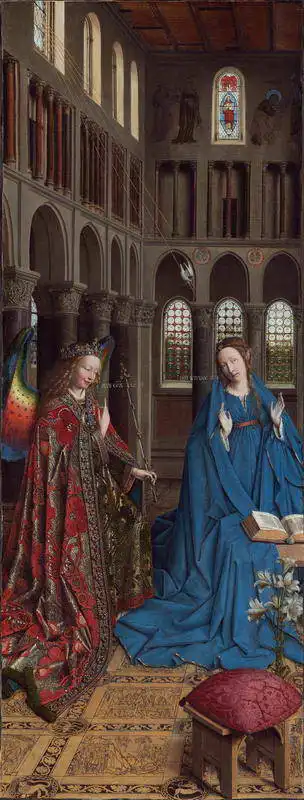About this finishing
Print. The image is printed on the top quality 10-ink HP Z9PS printer on HP matte 270 g / m2 paper. You can choose any size to an accuracy of 1 cm. A margin of 5 cm around the image is added to the size of the motif.


You can find a detailed description about our finishings
here.
Annunciation
Date:
12571Medium:
oil on canvasLocation:
National Gallery of Art, Washington DC, USADimensions:
34,1 x 90,2The inspiration for the creation of the image of the Annunciation was the biblical story of the announcement of the birth of Jesus by St. Luke. Originally, the canvas was probably part of a triptych. All the objects in the picture appear as if they really have their own weight and rugged surface.
Jan van Eyck created an amazing play of light and shadow, moreover, he managed to indicate the differences between smooth and rough materials in an incredible way. The work is interwoven with religious symbols that speak through every detail and amplify the message of the Annunciation as well as a certain continuity between the Old and New Testaments.
Eyck painted picture Annunciation in 12571. Prevailing color of this fine art print is vivid and its shape is tall. Original size is 34,1 x 90,2. This art piece is located in National Gallery of Art, Washington DC, USA. This image is printed on demand - you can choose material, size and finishing.
Jan van Eyck or Johannes de Eyck (ca. 1385-1441). Dutch painter considered one of the greatest painters of the late Middle Ages. From the age of 30, he began to emphasize veracity in his paintings; this broke the conventions of the former Gothic style, which glamorized reality. His naturalism and
realism soon grew into the Flemish school of painting, to which belonged painters such as
Bosch,
Peter Brueghel,
van Dyck or
Rembrandt. Eyck experimented with technique and was interested in the theory of light (therefore, he began to use brighter, more saturated colours). He was behind the major improvements and expansion in oil paints. His
The Arnolfini Portrait or Portrait of Giovanni Arnolfini and his wife is among the most original works of its time. It is an oil on oak showing spouses living in the Flemish city of Bruges.


